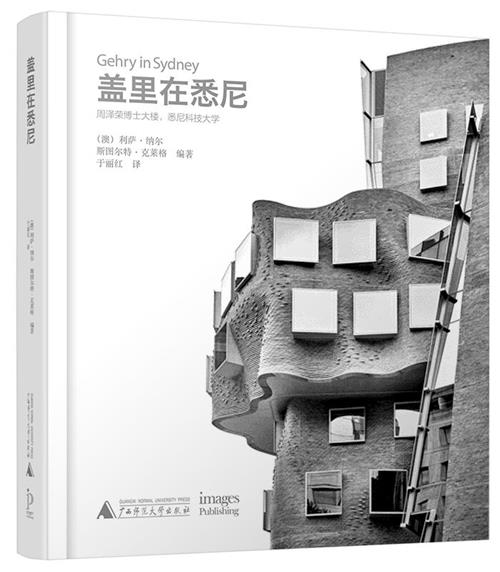
出版时间:2016-01-01
定 价:198.00
作 者:(澳)利萨·纳尔 斯图尔特·克莱格 编 于丽红 译
责 编:肖莉 于丽红
图书分类: 建筑外观设计
读者对象: 建筑、规划设计单位、设计师、学生
上架建议: 建筑设计
开本: 16
字数: 40 (千字)
页数: 288

弗兰克•盖里,是同时代最有影响力的建筑师之一,因很多地标性建筑而闻名世界。他的经典作品包括捷克布拉格的跳舞大楼(1996),西班牙的毕尔巴鄂古根汉姆博物馆(1997),洛杉矶的华特迪士尼音乐厅(2003)和普林斯顿大学的皮特•B.路易斯图书馆(2008年)等。本书对悉尼科技大学的周泽荣博士大楼的整个施工流程提供了新颖的分析,对建筑的城市环境、流程中的谈判、工作的委任,以及建筑的设计与施工提供了深刻的见解意见。
书中详细介绍了悉尼科技大学商学院教学楼,包含精美图片、见解独特的文字,全彩的模型,随笔和草图;周泽荣博士大楼是悉尼的第三大地标性建筑;以和弗兰克•盖里与克雷格•韦伯的对话为特色,对盖里工作流程的很多细节进行了沟通;对所有的建筑师、设计师、商学院和大学有一定的借鉴意义。
利萨•纳尔,是澳大利亚悉尼科技大学博士后研究员,曾经创作过专题作品《格伦•马库特,建筑师》,专攻桥梁设计和组织原理。
斯图尔特•克莱格,是悉尼科技大学的管理学教授,曾出版过很多书籍与论文,对空间和施工环境非常有兴趣。
目录
9 项目细节
11 前言 罗丝•米本尔
悉尼科技大学校长, 2002年—2014年
17 环境 体验城市
米歇尔•兰乔内
33 委托 变化的商学院
米歇尔•兰乔内
43 图纸
65 对话 弗兰克•O. 盖里与利萨•纳尔的对话
克雷格•韦伯与利萨•纳尔的对话
布拉德•温克尔约翰与利萨•纳尔的对话
89 概念 透过模型看建筑
利萨•纳尔与斯图尔特•克莱格
107 模型
135 施工 这种技术创新,但和我们通常所了解的不同
佩里•福赛斯
155 竣工
253 行业的传奇 如果建筑能说话
利萨•纳尔与玛丽安•斯唐•瓦兰
273 版权 项目团队
盖里建筑师事务所
图片
贡献者
想了解盖里大师的著名作品——周泽荣博士大楼吗?想了解盖里大师的创作过程吗?通过阅读本书,您能看到在周泽荣博士大楼的建造过程中,盖里大师是如何体验建筑的城市环境;如何进行委托谈判与流程沟通;如何思考建筑的设计与施工。如果建筑会说话,它就会告诉你,盖里大师的作品和创作流程都是业界的传奇。
变化的商学院
A changing business school
Following the demolition of the Dairy Farmers Co-operative Milk Company’s warehouse in 2010, until the beginning of preliminary excavation in early 2012, the site of the Dr Chau Chak Wing Building was used as an open-air parking lot. In those days the place looked more or less like a void surrounded by other, yet-to-change, rusty and muddy spaces. In early 2010 the new Goods Line pedestrian link didn’t exist; most of the new UTS facilities were still on paper and Frank Gehry’s first sketch of the Dr Chau Chak Wing Building was still to be drawn. How, then, have we moved from that situation to the one we can experience today? How, in other words, did change take place?
Building a new facility is neither a matter only of designing it (see Concept, p.81) nor is it only a matter of complex engineering calculus and complex, demanding and skilled work (see Construction, p.121). Before design, bricks, joints, concrete and cables fit together there are people who meet, speak, argue … and dream of possible futures. The building may not even be there in their thoughts: it materialises only at a certain point, as an intersection of needs, wishes and actions that, like threads, become woven into a fabric. To grasp how this actually occurs we need to confront the process of change. Rather than understanding change in its most canonical form — as matter of stages, a passage from A (the parking lot) to B (the building) — one needs to focus on the processual movements between A and B. In other words it is necessary to move from a macro perspective — which tells us the obvious: we don’t have a parking lot anymore — to a micro one:
[F]rom a distance (the macro level of analysis), when the observer examines the flow of events that constitute organising, they see what looks like repetitive action, routine, and inertia dotted with occasional episodes of revolutionary change. But a view from closer in (the micro level of analysis) suggests ongoing adaptation and adjustment.1
Looking closely at these micro-movements it is possible to unravel the heterogeneous set of material and immaterial elements that gradually become woven together, held together by the discursive, visionary and emotional bonds they share (and by the power and interests guiding them). Despite what the commercial management literature says, the process is not necessarily a harmonious one and cannot be planned in the form of a step-by-step guide. As the story of the Dr Chau Chak Wing Building commission shows, processes of change are characterised not only by careful planning and hard work but also by their alignment to other changes (both contextual and broader) and serendipitous encounters.2
We have already addressed the first contextual change — initiated both by the UTS City Campus Master Plan and by other developments affecting Ultimo (see Context, p.17). The second broader change influencing the development of the Dr Chau Chak Wing Building related to the ways in which business education has gradually been subject to redefinition, rethinking, indeed, even contestation, in recent years. Such redesign has been made in an attempt to address the challenges of an increasing globalising world, as well as in response to the perception by many commentators that business schools, particularly in their finance and economics disciplines, were a contributory factor inducing the irrational exuberance of financialisation that bankrupted major economies globally. Leading business schools are thus redesigning their curricula, introducing a new emphasis on interdisciplinary approaches, experiential learning, and creativity, which are perceived, in part, as a panacea for the above issues.3 The new emphasis parallels a renewed attention being paid to those spaces in which learning takes place, typified by the increased number of business schools designed by internationally renowned architects.4 The changes undertaken by the UTS Business School can be seen as largely aligning with this framework. The alignment was initiated with the appointment of a new dean for the UTS Business School in 2008, Professor Roy Green. Green had a clear idea of how to pursue UTS’ main goal (to become a ‘world leading university of technology’), in part informed by what other global business schools were doing at the time:
How would we do that? We’d do that by linking creativity, technology and innovation. That’s really the ethos of the place.
A ‘strategic conversation’ was organised to strengthen and test new and emergent ideas. The conversation, conducted and facilitated by a consulting company, which lasted from April through to December 2009, consisted of a series of workshops in which members of the UTS Business School discussed the world after the financial crisis in terms of the challenges confronting business education. Key points of change were identified, among which were the need for a better integration of the different disciplines and curricula, a more interactive and creative approach to teaching, and the importance of forging and maintaining strong connections with industry.
At that time the Dean had won the Business School’s approval for the construction of a new building, something that played an important role in the conversation. Attention turned to the ways in which the building presently occupied by the school did not facilitate interactive engagement, serendipitous collaboration between different areas and interdisciplinary work generally. The new space, it was strongly suggested, in conversations led by the Dean and the consultants, should reflect the emerging stress being placed on interaction, flexibility and creativity in the new vision that was being developed. A new building was seen as a medium for achieving the kinds of integrated and more porous teaching and learning experiences that the Dean’s vision for the UTS Business School was aiming to provide.
At the time the building was no more than a letter of intent – no architect had been appointed to design it. However, during a conversation with the Dean Roy Green, Stewart Clegg and Faculty Manager Bill Paterson, Maureen Thurston – at the time, one of the consultancy associates facilitating the strategic conversation – who happened to have known Gehry for more than 30 years, suggested Frank Gehry as a possible architect. Gehry had worked with business schools previously: in 2002 his design for the Weatherhead School of Management at Case Western Reserve University in Cleveland was built; he was also responsible for the Peter B. Lewis Library (2008) at Princeton University, and the Ray and Maria Stata Center (2004) at the Massachusetts Institute of Technology (MIT). Gehry’s work was seen as the perfect representation of many of the strategies formulating the new vision of the Business School. Having said that, it is one thing to think of Gehry; it is a totally different endeavour to have him working with you. With the subsequent enthusiastic support of UTS Vice-Chancellor Ross Milbourne, Thurston offered to contact Gehry. This is her account of the story:
So what actually happened was, it was a bit of a flash. I went up to [the dean] and [...] I mentioned to him, just offhandedly: Look, if you’re interested, would you like to have the equivalent of Frank Gehry do the building? He looked at me and he said, yes that would be good. I said, well if you’re serious, I can give him a call. He said [...] yes that’d be great so I called Frank over the weekend. Frank, I love him dearly but he still challenged me and said, are you sure that this is something that’s worth my time? I go, yes and he says, and this is project, is it really good to go? I go, yes, it really is good to go. [. . .] He said, okay then I’ll come. I’m flying back from Dubai, I’ll just swing over and visit. I said, okay, hung up the phone again, called [the dean] and said, yes he’ll come by in a couple of weeks as he’s coming back from Dubai on his way back to LA. So it all happened within, me tapping [the dean] on the shoulder and asking him if he’d be interested and two days later, Frank had made plans to visit.
Buildings, so material, so evidently there, sometimes result from almost random encounters, emerging from a stroke of luck, a conjuncture at one instant that, if it had been missed, would never have seen the imagined built form actually materialise.

|

|

|
| 会员家 | 书天堂 | 天猫旗舰店 |
 |  |
| 微信公众号 | 官方微博 |
版权所有:广西师范大学出版社集团 GUANGXI NORMAL UNIVERSITY PRESS(GROUP) | 纪委举/报投诉邮箱 :cbsjw@bbtpress.com 纪委举报电话:0773-2288699
网络出版服务许可证: (署) | 网出证 (桂) 字第008号 | 备案号:桂ICP备12003475号 | 新出网证(桂)字002号 | 公安机关备案号:45030202000033号